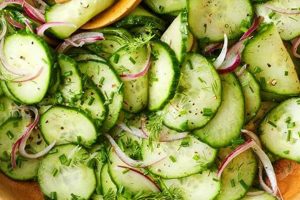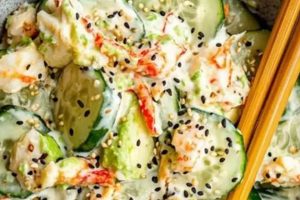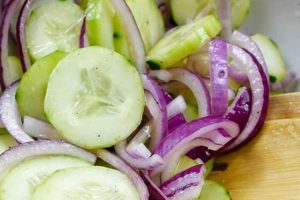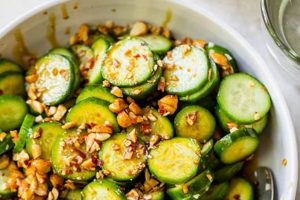A refreshing and flavorful dish featuring sliced tomatoes, onions, and cucumbers typically combined with a vinaigrette or other light dressing. Variations may incorporate additional ingredients like herbs, spices, or other vegetables. This simple combination offers a healthy and hydrating side dish suitable for a variety of cuisines and occasions.
The inherent simplicity and adaptability of this salad contribute to its widespread appeal. The ingredients offer a range of nutritional benefits, including vitamins, minerals, and antioxidants. Historically, salads composed of fresh, raw vegetables have been consumed across cultures for centuries, offering a readily available source of sustenance and flavor. The versatility of this particular combination allows for customization based on personal preference and seasonal availability.
Further exploration will cover variations on the basic formula, including different dressings, additional ingredients, and tips for selecting the best produce. Nutritional information and specific recipes will also be provided.
Tips for a Perfect Tomato, Onion, and Cucumber Salad
Achieving optimal flavor and texture requires attention to detail in ingredient selection and preparation. The following tips offer guidance for creating a superior salad.
Tip 1: Ingredient Selection: Opt for ripe, in-season tomatoes for the best flavor. Consider heirloom varieties for unique color and taste profiles. Choose firm cucumbers and onions with no signs of bruising or softening.
Tip 2: Knife Skills: Uniform slicing ensures even distribution of flavor and a pleasing presentation. Aim for consistent thickness when slicing the vegetables. A sharp knife is essential for clean cuts.
Tip 3: Salting and Draining: Salting cucumbers and onions before combining them with other ingredients draws out excess moisture, preventing a watery salad. Allow the salted vegetables to rest in a colander for at least 15 minutes before rinsing and drying thoroughly.
Tip 4: Dressing Selection: A simple vinaigrette complements the fresh flavors of the vegetables. Experiment with different oils and vinegars to find a preferred balance of acidity and richness. Consider adding herbs or spices to the dressing for an extra layer of flavor.
Tip 5: Chilling: Chilling the salad for a short time before serving allows the flavors to meld and enhances the refreshing quality of the dish. Avoid over-chilling, as this can dull the flavors.
Tip 6: Serving Suggestions: This salad pairs well with grilled meats, fish, or poultry. It can also be served as a light lunch or a refreshing side dish at a picnic or barbecue.
By following these tips, one can elevate a simple combination of vegetables into a truly delightful culinary experience.
Following these guidelines ensures a successful and enjoyable salad, highlighting the fresh, vibrant flavors of the individual components.
1. Fresh, High-Quality Ingredients
The success of a tomato, onion, and cucumber salad hinges directly on the quality of its ingredients. Freshness significantly impacts flavor, texture, and overall enjoyment. Subpar produce results in a bland, watery, or even unpleasant sensory experience. Conversely, vibrant, ripe tomatoes, crisp cucumbers, and pungent onions contribute distinct, desirable flavors and textures that elevate the simple combination to a culinary delight. This cause-and-effect relationship underscores the critical role of ingredient selection. For instance, using a mealy, out-of-season tomato will result in a lackluster salad, while a juicy, vine-ripened tomato contributes a burst of sweetness and acidity that enhances the entire dish.
Freshness extends beyond mere ripeness; it encompasses the overall condition of the produce. Blemishes, bruises, or signs of decay negatively affect both taste and visual appeal. Selecting firm, unblemished vegetables ensures optimal texture and flavor. A cucumber with soft spots, for instance, will have a mushy texture and may impart off-flavors. Similarly, an onion with sprouting greens will possess a harsher, less desirable taste. The practical application of this understanding mandates careful inspection and selection of ingredients at the point of purchase. Prioritizing quality produce ensures a successful and enjoyable salad.
In summary, the emphasis on fresh, high-quality ingredients is not merely a culinary suggestion but a fundamental requirement for a successful tomato, onion, and cucumber salad. Ingredient quality directly influences the final product’s flavor, texture, and overall appeal. Careful selection of produce ultimately determines the dish’s success, highlighting the inextricable link between quality ingredients and culinary outcome. Compromising on ingredient quality invariably compromises the final result.
2. Precise Cutting Techniques
Precise cutting techniques are integral to a successful tomato, onion, and cucumber salad, impacting both aesthetic presentation and flavor experience. Uniformity in size and shape ensures even distribution of flavor and a visually appealing result. Consistent cuts allow for predictable cooking or marinating times, should these elements be incorporated. Furthermore, precise cuts optimize surface area, maximizing exposure to dressings and promoting even flavor absorption. Conversely, unevenly cut pieces can lead to a disharmonious blend of textures and flavors, with some pieces potentially over- or under-dressed. For example, thinly slicing onions minimizes their pungency while thicker cuts retain a sharper bite. Similarly, uniformly diced cucumbers offer a consistent crunch, while uneven chunks can create an unbalanced textural experience.
The practical significance of this understanding extends beyond mere aesthetics. Precision in cutting facilitates even distribution of ingredients throughout the salad, ensuring every bite contains a balanced combination of flavors and textures. This contributes to a more harmonious and enjoyable culinary experience. Consider the difference between a salad composed of uniformly diced tomatoes and one with a mix of large chunks and small pieces. The latter presents an uneven distribution of tomato flavor and a less satisfying textural experience. Furthermore, precise knife skills minimize cellular damage to the vegetables, preserving their freshness and preventing excessive moisture release, which can lead to a watery salad.
In summary, precise cutting techniques are not simply a matter of presentation; they are fundamental to the overall success of a tomato, onion, and cucumber salad. They influence flavor distribution, texture, and the overall balance of the dish. Mastering these techniques elevates this simple salad from a basic combination of ingredients to a carefully constructed culinary creation. The practical application of precise cutting directly correlates with a more enjoyable and aesthetically pleasing final product, underscoring the critical role of knife skills in culinary endeavors.
3. Balanced Flavor Profiles
Balanced flavor profiles are essential to a successful tomato, onion, and cucumber salad. The inherent simplicity of this salad necessitates careful consideration of the interplay between sweet, acidic, savory, and pungent notes. A harmonious balance elevates the individual flavors, creating a complex and satisfying overall taste experience. An excess of any single flavor component can overwhelm the others, resulting in a less enjoyable outcome. For example, an overly acidic dressing can mask the sweetness of the tomatoes and cucumbers, while an abundance of onion can overpower the delicate flavors of the other vegetables. Conversely, a well-balanced flavor profile allows each ingredient to contribute its unique characteristics to the whole, resulting in a synergistic and refreshing culinary experience.
Achieving this balance requires an understanding of the inherent flavor profiles of each ingredient and how they interact with one another. Tomatoes contribute sweetness and acidity, cucumbers offer a refreshing coolness, and onions provide a pungent bite. The dressing plays a critical role in unifying these flavors, providing a backdrop against which the individual components can shine. A simple vinaigrette, for example, can provide the necessary acidity to balance the sweetness of the tomatoes while enhancing the crispness of the cucumbers. The addition of herbs or spices can further enhance the complexity of the flavor profile, adding depth and nuance to the salad. A vinaigrette made with lemon juice and olive oil, for instance, provides a bright, acidic counterpoint to the sweetness of ripe tomatoes, while a touch of fresh dill adds a subtle herbal note that complements the cool cucumber. Careful consideration of these flavor combinations is crucial for achieving a well-balanced and enjoyable salad.
In summary, a balanced flavor profile is not merely a desirable characteristic but a fundamental requirement for a successful tomato, onion, and cucumber salad. Understanding the interplay of flavors and the role of each ingredient is crucial for achieving a harmonious and satisfying result. The practical application of this understanding allows for the creation of a salad that is greater than the sum of its parts, transforming simple ingredients into a complex and refreshing culinary experience. Failure to achieve this balance can result in a dish that is one-dimensional and ultimately less enjoyable, highlighting the direct correlation between flavor balance and culinary success.
4. Optimal Ingredient Combinations
Optimal ingredient combinations are crucial for maximizing the flavor and textural complexity of a tomato, onion, and cucumber salad. While the foundational trio provides a refreshing base, strategic additions can elevate the dish from simple to exceptional. Consideration must be given to complementary flavors and textures that enhance, rather than detract from, the core ingredients. The interplay of these additions contributes significantly to the overall sensory experience. For example, incorporating feta cheese introduces a salty, creamy element that contrasts beautifully with the crisp vegetables and tangy vinaigrette. Similarly, adding fresh herbs like mint or dill provides aromatic complexity and a refreshing counterpoint to the other flavors. Conversely, incorporating ingredients with clashing flavors or textures can diminish the overall appeal. Adding strong-flavored cheeses like blue cheese, for instance, may overpower the delicate flavors of the vegetables. Similarly, incorporating ingredients with a similar texture, like chopped bell peppers, may result in a monotonous mouthfeel.
The practical application of this understanding involves careful consideration of flavor pairings and textural contrasts. Incorporating ingredients with complementary flavors, such as a sweet onion with a tart vinaigrette, creates a harmonious balance. Adding ingredients with contrasting textures, such as crunchy croutons or toasted nuts, adds depth and interest to the salad. Furthermore, varying the colors of the added ingredients enhances the visual appeal of the dish, making it more enticing. Adding brightly colored cherry tomatoes or a sprinkle of chopped parsley, for example, can transform a simple salad into a visually stunning culinary creation. The quantity of added ingredients also plays a vital role; over-crowding the salad can dilute the flavors and compromise the overall balance.
In summary, optimal ingredient combinations are essential for elevating a tomato, onion, and cucumber salad from a basic dish to a culinary masterpiece. Careful consideration of flavor pairings, textural contrasts, and visual appeal allows for the creation of a balanced and complex salad that tantalizes the taste buds. Practical application of these principles ensures that the added ingredients enhance, rather than detract from, the core flavors of the salad. A well-composed tomato, onion, and cucumber salad exemplifies the power of thoughtful ingredient selection in creating a truly exceptional culinary experience.
5. Appropriate Seasoning
Appropriate seasoning is fundamental to a successful tomato, onion, and cucumber salad, elevating the natural flavors of the fresh ingredients. It transforms a simple combination of vegetables into a vibrant, flavorful dish. The correct balance and application of seasonings amplify the inherent sweetness, acidity, and subtle nuances of the core components. Understanding the role of various seasonings and their impact on the final product is crucial for achieving optimal results. Improper seasoning can easily mask the delicate flavors of the vegetables, resulting in a bland or unbalanced dish. Conversely, thoughtful seasoning enhances the overall sensory experience, creating a harmonious and satisfying culinary creation.
- Salt:
Salt is the cornerstone of seasoning, enhancing the natural sweetness of the tomatoes and cucumbers while tempering the sharpness of the onions. It draws out moisture, intensifying flavors and creating a more vibrant taste experience. The type of salt used can also influence the final result. Coarse kosher salt or sea salt provides a clean, briny flavor, while table salt can sometimes impart a metallic taste. The amount of salt used should be carefully calibrated to avoid over-salting, which can overwhelm the delicate flavors of the vegetables. A light hand and gradual addition, tasting frequently, ensures proper seasoning.
- Pepper:
Freshly ground black pepper adds a subtle layer of complexity, providing a gentle heat and a nuanced spice note that complements the fresh vegetables. Pre-ground pepper often lacks the vibrancy and depth of flavor found in freshly ground peppercorns. The amount of pepper used should be adjusted according to personal preference, but a light touch is generally recommended to avoid overpowering the other flavors. White pepper can be used as an alternative for a milder flavor profile and to avoid the visible black specks.
- Acidity:
A touch of acidity, often in the form of vinegar or lemon juice, brightens the flavors of the salad and provides a counterpoint to the sweetness of the tomatoes and cucumbers. The type of acid used influences the final flavor profile. Red wine vinegar adds a robust, fruity note, while white wine vinegar offers a lighter, more delicate acidity. Lemon juice provides a bright, citrusy tang. The amount of acid should be carefully balanced to avoid overwhelming the other flavors. A light hand and frequent tasting are crucial for achieving the desired balance.
- Herbs and Spices:
Fresh herbs, such as dill, mint, or parsley, add a layer of aromatic complexity and freshness to the salad. Dried herbs can also be used but should be added sparingly, as their flavor is more concentrated. The choice of herbs should complement the other ingredients and the overall flavor profile of the salad. A sprinkle of dried oregano, for instance, can add a Mediterranean touch, while fresh cilantro can provide a bright, herbaceous note. The use of spices should be judicious, ensuring they enhance rather than dominate the flavors of the fresh vegetables.
In conclusion, appropriate seasoning is an essential element in creating a truly exceptional tomato, onion, and cucumber salad. The judicious use of salt, pepper, acidity, and herbs elevates the natural flavors of the fresh ingredients, transforming a simple combination into a complex and satisfying culinary experience. The interplay of these seasonings creates a harmonious balance, enhancing the sweetness, acidity, and subtle nuances of the core components. Mastering the art of seasoning is crucial for achieving a salad that is both refreshing and flavorful, showcasing the potential of simple ingredients when thoughtfully combined.
6. Proper Storage Methods
Proper storage methods are crucial for maintaining the quality and maximizing the lifespan of a tomato, onion, and cucumber salad. Improper storage can lead to undesirable changes in texture, flavor, and overall appeal. These changes are primarily driven by enzymatic activity, oxidation, and microbial growth, all accelerated at room temperature. Refrigeration significantly slows these processes, preserving the salad’s freshness and preventing spoilage. Storing the salad in an airtight container further minimizes exposure to air and humidity, inhibiting oxidation and maintaining crispness. For example, storing cut cucumbers in a sealed container prevents them from drying out and becoming rubbery. Similarly, storing tomatoes in the refrigerator, away from direct sunlight, helps retain their vibrant color and prevents them from becoming mealy.
The practical significance of proper storage extends beyond mere preservation. Correct storage practices maintain the optimal flavor and texture of the salad, ensuring a consistently enjoyable culinary experience. Failure to adhere to these practices can result in a significant decline in quality, rendering the salad unappetizing or even unsafe to consume. For instance, a salad left at room temperature for an extended period may develop bacterial growth, posing a health risk. Furthermore, proper storage minimizes food waste, allowing for consumption over a longer period and maximizing the value of the ingredients. Storing leftover salad properly allows for enjoyment the following day without sacrificing quality.
In summary, proper storage is an essential aspect of maximizing the enjoyment and lifespan of a tomato, onion, and cucumber salad. Understanding the underlying mechanisms of deterioration and the preventative measures afforded by refrigeration and airtight storage allows for informed decision-making. This knowledge contributes directly to a safer, more enjoyable, and less wasteful culinary experience, highlighting the practical significance of proper food storage practices in preserving quality and minimizing spoilage. The application of these principles ensures the longevity and continued enjoyment of this simple yet refreshing culinary creation.
Frequently Asked Questions
This section addresses common inquiries regarding tomato, onion, and cucumber salads, providing concise and informative responses.
Question 1: How can one prevent a watery salad?
Salting the cucumbers and onions draws out excess moisture. Place the sliced vegetables in a colander, sprinkle with salt, and allow them to rest for 15-30 minutes before rinsing and thoroughly drying. This process significantly reduces water content and prevents a diluted dressing.
Question 2: What are the best tomato varieties for this salad?
Ripe, in-season tomatoes offer optimal flavor. Heirloom varieties provide unique color and taste profiles. Consider the sweetness and acidity of different varieties when selecting tomatoes for the salad. The choice depends on individual preference and desired flavor profile.
Question 3: Can this salad be prepared in advance?
While the salad is best consumed fresh, it can be prepared a few hours in advance. Store the vegetables and dressing separately and combine them just before serving. This prevents the vegetables from becoming soggy and maintains the dressing’s integrity.
Question 4: How can one enhance the flavor profile of the dressing?
Experimenting with different oils and vinegars allows for customized flavor profiles. Consider adding fresh herbs, spices, or a touch of sweetness, such as honey or maple syrup, to enhance the complexity of the vinaigrette. The addition of Dijon mustard can also add depth and creaminess.
Question 5: What are suitable pairings for this salad?
This salad complements grilled meats, fish, poultry, and vegetarian dishes. It serves as a refreshing side dish for barbecues, picnics, and potlucks. The versatility of the salad makes it suitable for a variety of cuisines and occasions.
Question 6: How long can the salad be stored in the refrigerator?
When stored properly in an airtight container, the salad can be refrigerated for up to two days. However, consuming it within 24 hours is recommended for optimal flavor and texture. Beyond this timeframe, the vegetables may become overly soft and lose their crispness.
Understanding these key aspects optimizes the preparation and enjoyment of a tomato, onion, and cucumber salad. Careful consideration of each element ensures a flavorful and refreshing culinary experience.
The following sections will provide specific recipes and variations to further explore the versatility of this simple yet satisfying dish.
Tomato, Onion, and Cucumber Salad
This exploration has delved into the multifaceted nature of the tomato, onion, and cucumber salad, emphasizing the importance of ingredient quality, precise cutting techniques, balanced flavor profiles, optimal ingredient combinations, appropriate seasoning, and proper storage methods. Each element contributes significantly to the final product, impacting flavor, texture, and overall enjoyment. The seemingly simple combination of ingredients offers a canvas for culinary creativity, allowing for personalized variations while adhering to fundamental principles of flavor balance and ingredient harmony.
Culinary success hinges on a thorough understanding of these principles. Application of these concepts transforms a basic combination of ingredients into a refreshing and flavorful culinary experience. Further exploration and experimentation with various flavor combinations and additions offer continued opportunities for culinary discovery and personalized enjoyment. The potential for customization ensures this classic salad remains a versatile and enduring culinary staple.






